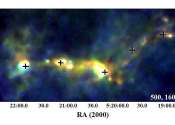Mystery of planet-forming disks explained by magnetism
(Phys.org) —Astronomers say that magnetic storms in the gas orbiting young stars may explain a mystery that has persisted since before 2006.

(Phys.org) —Astronomers say that magnetic storms in the gas orbiting young stars may explain a mystery that has persisted since before 2006.
Astronomy
Mar 7, 2014
62
0

Using data from various space telescopes and astronomical surveys, Armenian researchers have investigated three star-forming regions. The study identified hundreds of young stellar objects and provided important information ...

We only have one example of a planet with life: Earth. But within the next generation, it should become possible to detect signs of life on planets orbiting distant stars. If we find alien life, new questions will arise. ...
Astronomy
Aug 27, 2015
10
165

New research by Stella Offner, assistant professor of astronomy at The University of Texas at Austin, finds that magnetic waves are an important factor driving the process of star formation within the enormous clouds that ...
Astronomy
Sep 13, 2018
205
529

Patches of bright pink and wisps of dark red paint the foreground of this new NASA Hubble Space Telescope image. NGC 5068 is a barred spiral galaxy with thousands of star-forming regions and large quantities of interstellar ...
Astronomy
Oct 9, 2023
0
10

(Phys.org)—Although NASA's Hubble Space Telescope has taken many breathtaking images of the universe, one snapshot stands out from the rest: the iconic view of the so-called "Pillars of Creation." The jaw-dropping photo, ...
Astronomy
Jan 6, 2015
0
68

Star and planet formation is a messy affair. It starts with the gravitational collapse of a gigantic cloud of gas and dust, which simultaneously produces massive stars, whose intense radiation field creates a harsh environment, ...
Astronomy
May 14, 2024
0
87

Using the Atacama Large Millimeter/submillimeter Array (ALMA), an international team of astronomers observed an interstellar medium in a distant star-forming galaxy SPT0346-52. The collected data could be essential in improving ...

With an instrument at the Very Large Telescope in Chile scientists of ETH Zurich observed planet-forming disks around young stars similar to the sun 4,5 billion years ago. Surprisingly, the disks are very different. The data ...
Astronomy
Apr 12, 2018
24
533

Thousands of never-before-seen young stars are spotted in a stellar nursery called 30 Doradus, captured by the NASA/ESA/CSA James Webb Space Telescope. Nicknamed the Tarantula Nebula for the appearance of its dusty filaments ...
Astronomy
Sep 6, 2022
0
351